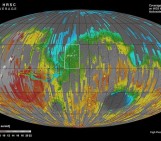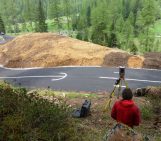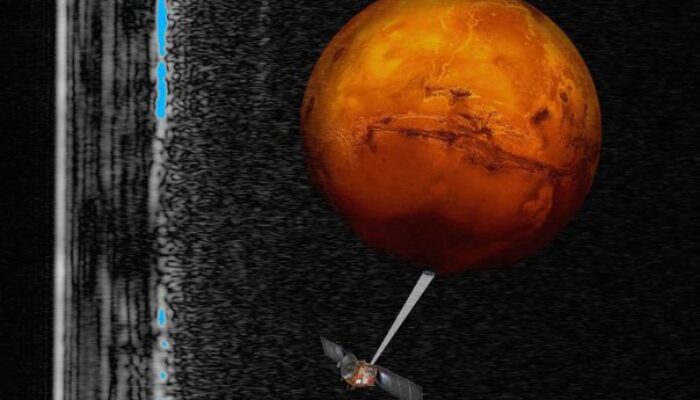
Drawing inspiration from popular stories on our social media channels, as well as unique and quirky research news, this monthly column aims to bring you the best of the Earth and planetary sciences from around the web.
Major stories
Signs of water 55 million kilometres away
Last week scientists announced that they have found signs of existing water on Mars, offering new hope to the possibility of uncovering life on the Red Planet’s subsurface.
Radar observations made by the European Space Agency’s Mars Express satellite, suggest that a liquid lake is buried 1.5 kilometres beneath an ice cap situated near the south pole of Mars. Scientists think that this body of water is likely a few metres deep and 20 kilometres across, “nearly three times larger than the island of Manhattan,” reported Scientific American.
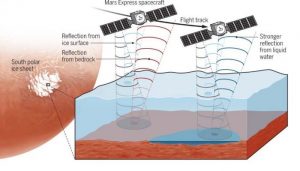
A schematic of how scientists used radar to find what they interpret to be liquid water beneath the surface of Mars. (Credit: ESA)
For the last 12 years the Mars Express satellite has been taking measurements of Mars by sending beams of radar pulses into the planet’s immediate interior. As these waves bounce back, the brightness of the reflection gives information on the material lying beneath Mars’ surface.
The researchers involved came across this discovery while analysing three years worth of data collected by the spacecraft.
“The bluer the colors, the brighter the radar reflection from the material it bounced off. The blue triangle outlined in black in the middle is the purported lake,” reported Science News.
Previous observations, made by NASA’s Curiosity rover for example, have found lake beds on the planet’s exterior, signifying that water may have flowed on Mars in the past. However, if this new finding is confirmed, it would be the first discovery of an existing stable body of water, one of the conditions believed to be necessary for life to thrive.
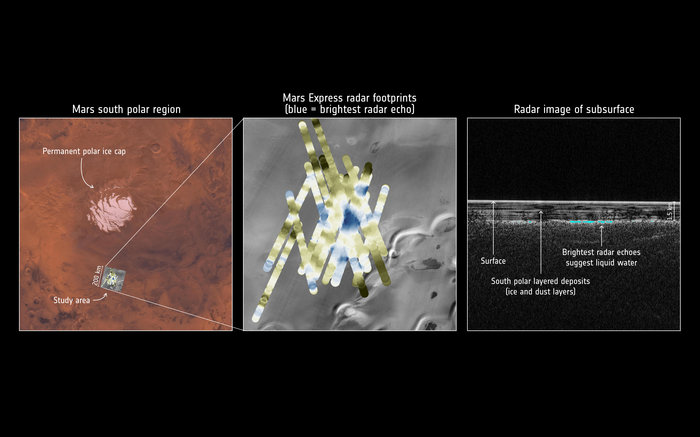
Context map: NASA/Viking; THEMIS background: NASA/JPL-Caltech/Arizona State University; MARSIS data: ESA/NASA/JPL/ASI/Univ. Rome; R. Orosei et al 2018 (distributed via ESA)
“We are not closer to actually detecting life,” said Manish Patel from the Open University to BBC News, “but what this finding does is give us the location of where to look on Mars. It is like a treasure map – except in this case, there will be lots of ‘X’s marking the spots.”
In their study, published in Science last week, the team remarked, “there is no reason to conclude that the presence of subsurface water on Mars is limited to a single location.”
Northern hemisphere feels the heat
In other news, the two words best describing the northern hemisphere this summer could very well “hot” and “dry,” as a series of heat waves have taken hold of several regions across Europe, Asia, North America and northern Africa. Many countries this month, including Japan, Algeria and Canada, have even experienced record-breaking temperatures.
A look at how this year’s heatwave has changed the colour of our vegetation in just one month (Credit: ESA)
For some places, above average temperatures and dry conditions have helped fuel devastating wildfires. More than 50 wildfires have swept through Scandinavian forests this summer, many well within the Arctic Circle, causing Sweden to request emergency aid from nearby countries.
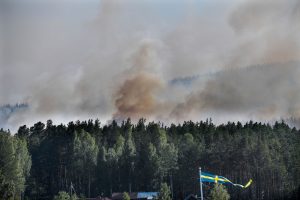
Smoke rises from a wildfire in Enskogen. (Credit: Swedish Environmental Protection Agency/Maja Suslin)
A major wildfire also ignited near Athens, Greece this month, resulting in more than 85 death, with dozens still missing. While Greek officials claim that there are “serious indications” that the flames were brought upon by arson, they also note that the region’s climate conditions were extreme.
To many scientists, this onslaught of hot and dry conditions is a taste of what may soon become the norm. Of course, these conditions (in Europe, for example) are partly due to weather. “The jet stream – the west-to-east winds that play a big role in determining Europe’s weather – has been further north than usual for about two months,” reports the Guardian, leading to sweltering conditions in the UK and much of Europe, while leaving Iceland cool and stormy.
However, scientists say that heatwaves in the northern hemisphere are very much linked to global warming. “There’s no question human influence on climate is playing a huge role in this heatwave,” said Myles Allen, a climate scientist at the University of Oxford, to the Guardian in the same article.
A recent assessment on the ongoing heat wave in Europe reports that these conditions are more likely to occur due to climate change. “The findings suggest that rising global temperatures have increased the likelihood of such hot temperatures by five times in Denmark, three times in the Netherlands and two times in Ireland,” said Carbon Brief.
What you might have missed
Geologists have given a name to Earth’s most recent chapter: Meghalayan Age. The announcement was made earlier this month when the International Union of Geological Sciences updated the International Chronostratigraphic Chart, which classifies Earth’s geologic time scale. The new update has divided the Holocene Epoch (the current time series which began 11,700 years ago, when the Earth was exiting its last ice age) into three stages: the Greenlandian, the Northgrippian, and then Meghalayan.
The Meghalayan Age represents the time between now and 4,200 years ago, when a mega-drought led to the collapse of many civilisations across the world. The middle phase, Northgrippian (from 8,300 years ago to 4,200 years ago), is marked by an sudden cooling event brought on by massive glacial melt in Canada that affected ocean currents. Finally the oldest phase, Greenlandian, (from 11,700 years ago to 8,300 years ago) is marked by the end of the last ice age.
The recent update has created some unrest in the geosciences community. “There is still an active debate about assigning a new geologic slice of time to reflect specifically the influence of humans on the planet,” reported BBC News. Some scientists say that the new divisions conflict with the current work being done on proposing a new epoch classification, famously called the ‘Anthropocene,’ which would be marked by the beginning on significant human impact on Earth’s geology and ecosystems.
Links we liked
- Ursula B. Marvin (1921–2018): this bold mineralogist and feminist bucked norms that deemed geology unsuited for women
- Updating maps swiftly after natural disasters: satellite imagery and artificial intelligence could help speed disaster relief by quickly mapping landslides
- Does soil really affect wine’s flavour?: The idea that a vineyard’s soil lends a wine its flavour is becoming increasingly popular – but is there any scientific basis?
- How Kilauea—and other volcanoes—produce amazing and frightful weather: Volcanic tornadoes, choking fog, “laze,” lightning, hail, waterspouts and even frost are created above hot eruptions
The EGU story
This month we released not one but two press releases from research published in our open access journals. The findings from both studies have important societal implications. Take a look at them below.
New study: oxygen loss in the coastal Baltic Sea is “unprecedentedly severe”
The Baltic Sea is home to some of the world’s largest dead zones, areas of oxygen-starved waters where most marine animals can’t survive. But while parts of this sea have long suffered from low oxygen levels, a new study by a team in Finland and Germany shows that oxygen loss in coastal areas over the past century is unprecedented in the last 1500 years. The research was published in the European Geosciences Union journal Biogeosciences.
New study puts a figure on sea-level rise following Antarctic ice shelves’ collapse
An international team of scientists has shown how much sea level would rise if Larsen C and George VI, two Antarctic ice shelves at risk of collapse, were to break up. While Larsen C has received much attention due to the break-away of a trillion-tonne iceberg from it last summer, its collapse would contribute only a few millimetres to sea-level rise. The break-up of the smaller George VI Ice Shelf would have a much larger impact. The research was published in the European Geosciences Union journal The Cryosphere.
And don’t forget! To stay abreast of all the EGU’s events and activities, from highlighting papers published in our open access journals to providing news relating to EGU’s scientific divisions and meetings, including the General Assembly, subscribe to receive our monthly newsletter.

